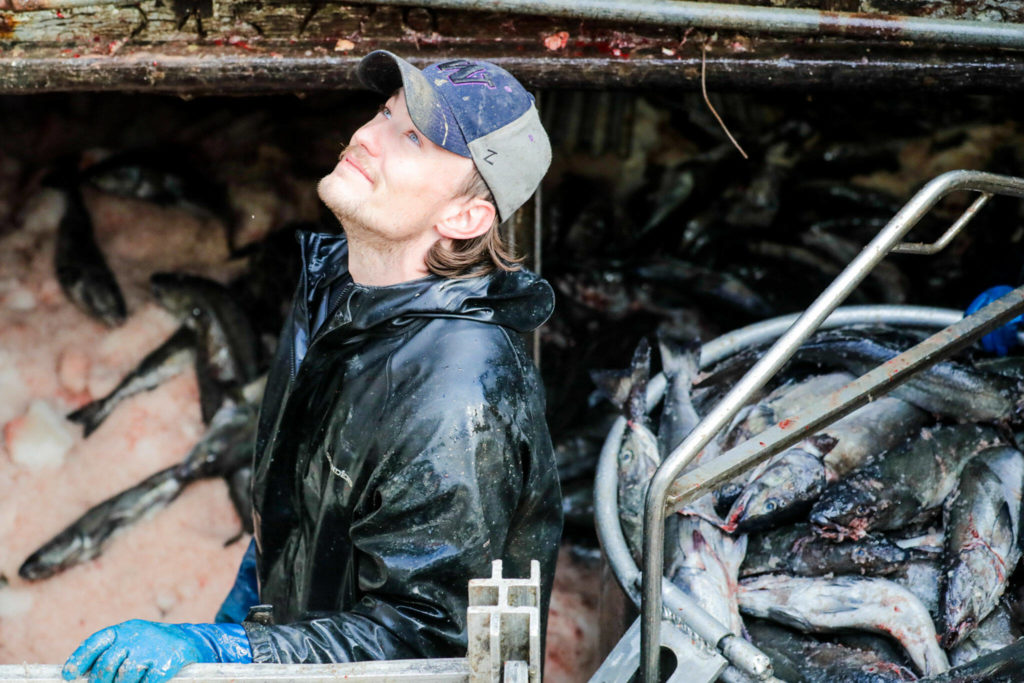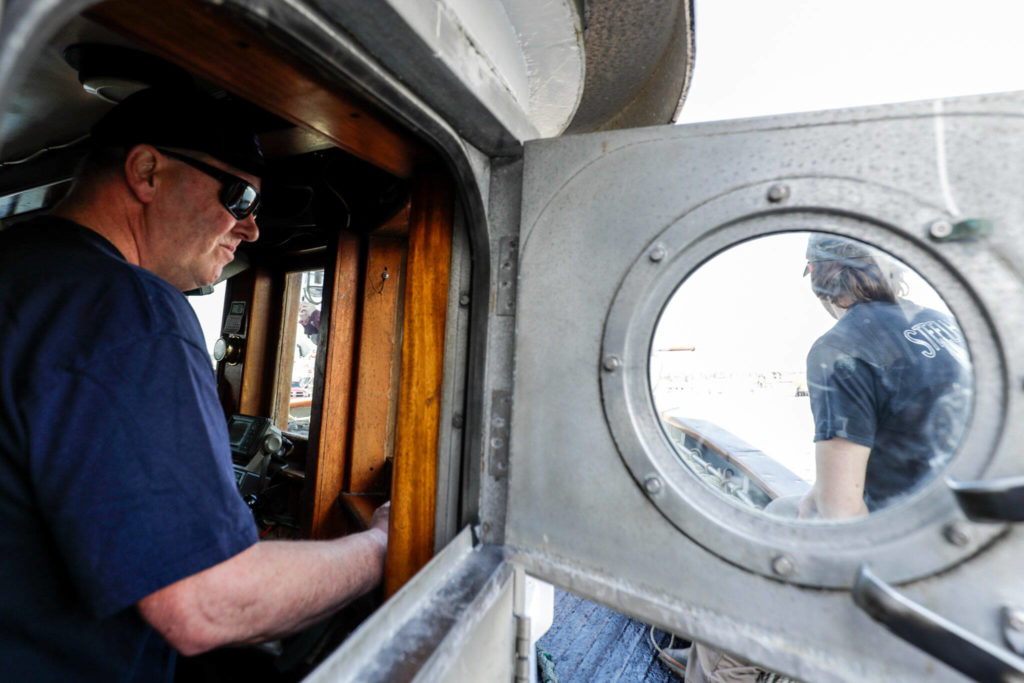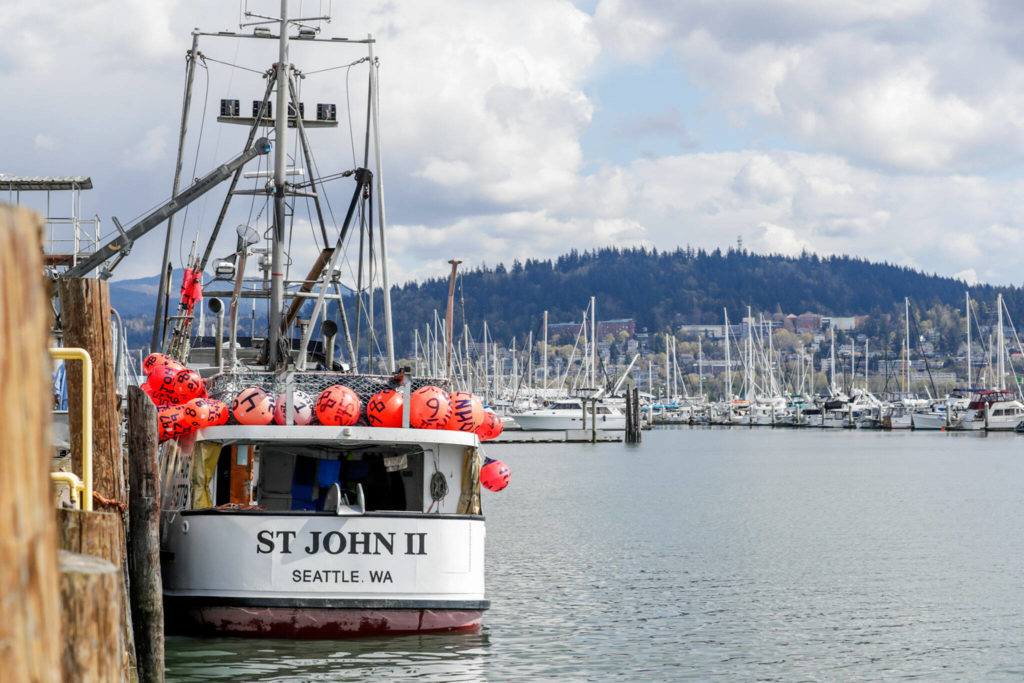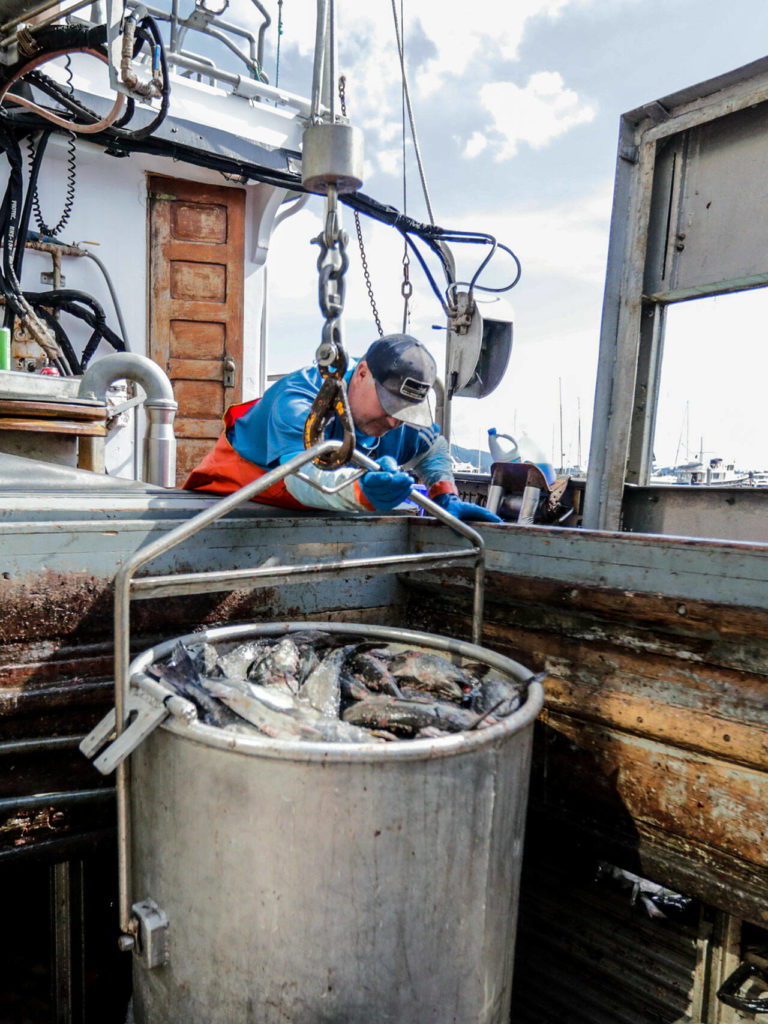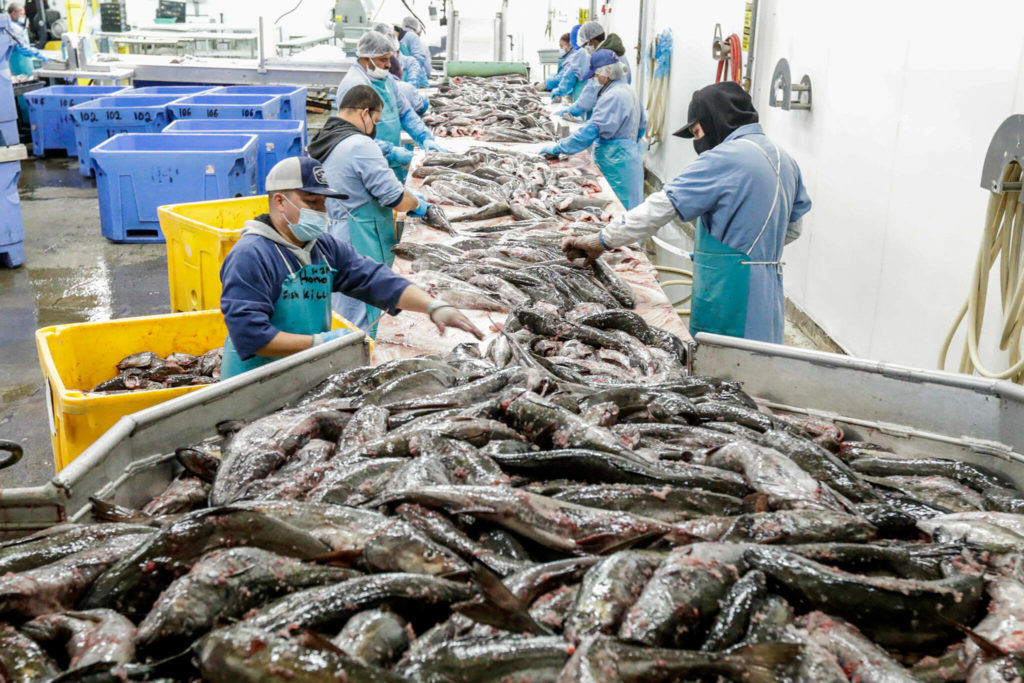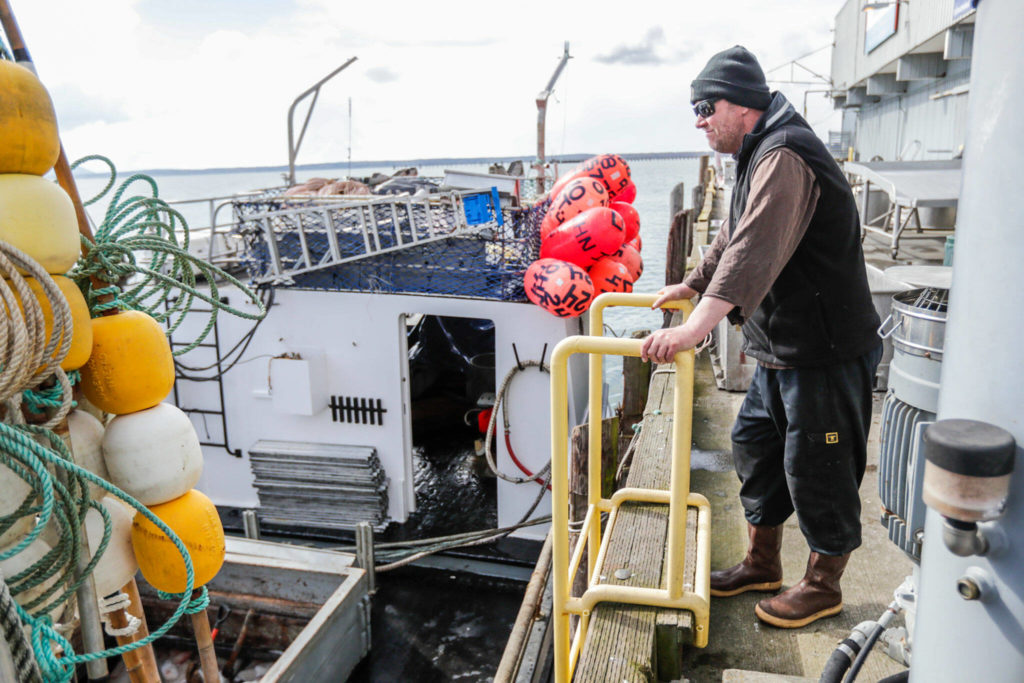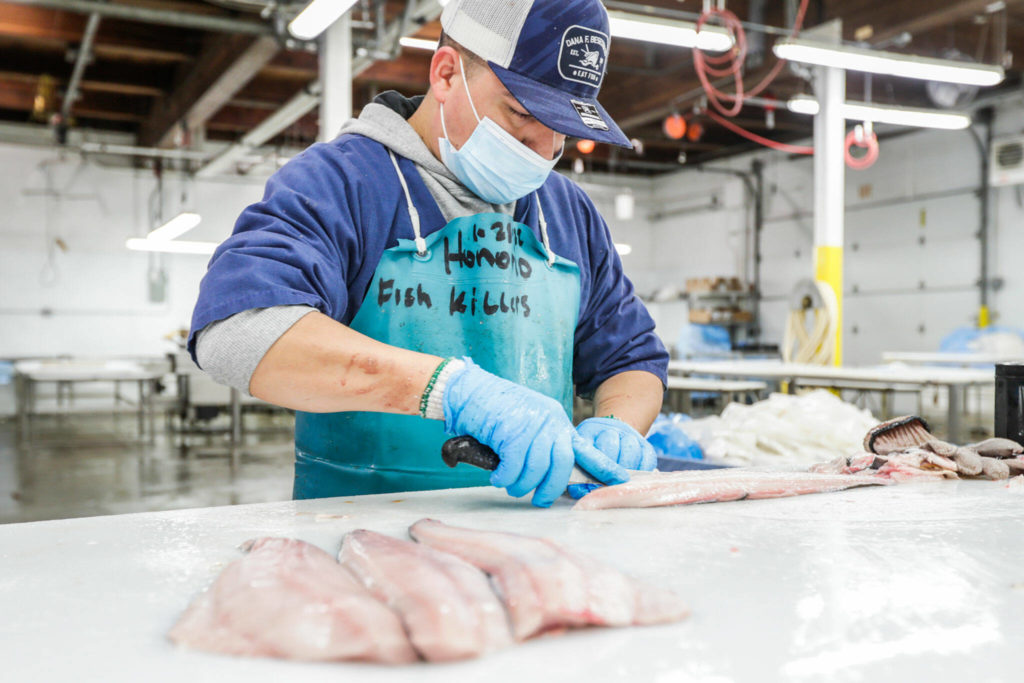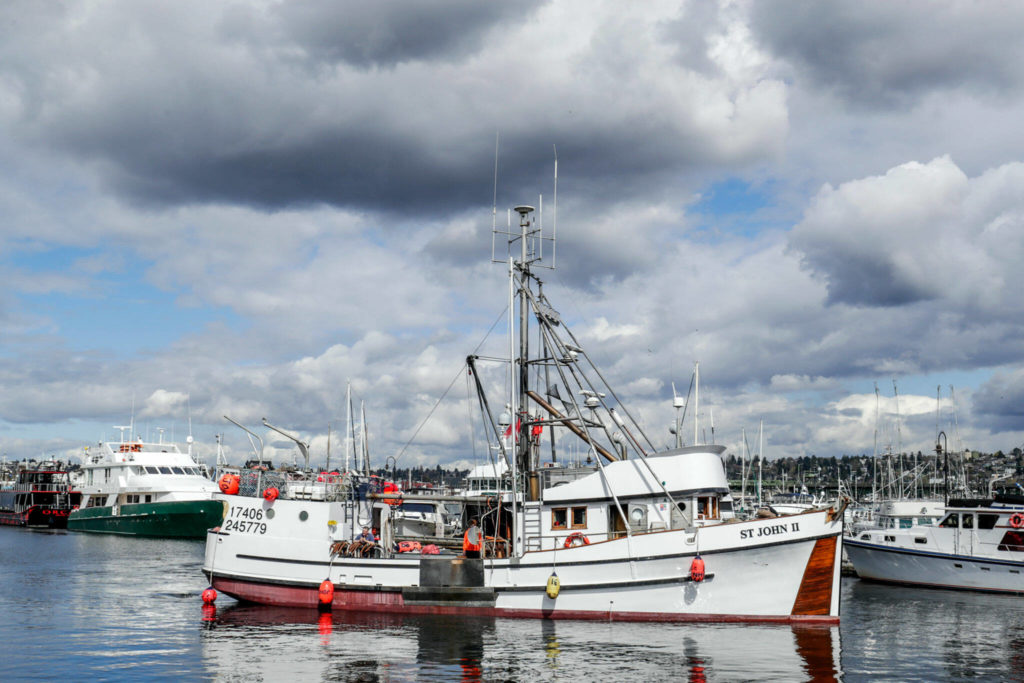SNOHOMISH — Before it reached your plate, before its aroma lingered in the house as you basted it with butter and herbs, and before you spotted the raw filet at the farmers market, the halibut took the bait.
Your dinner was pulled hundreds of feet to the surface, where a fisherman reached over the gunwale of a decades-old wooden boat and hooked the flatfish’s heavy body out of the cold, deep sea.
Another bib-clad fisher killed the halibut swiftly, packed it with crushed ice and lowered it down to the boat’s hold.
One at a time, halibut by halibut, the five-man crew aboard the St. John II pulls in their livelihood by hand — the same way Gary Olsen’s family has fished for the past century. For a week straight, the crew wakes up just before 5. They guzzle coffee and head up to the deck. There is no time to waste. For the next 19 hours, they set miles of line and haul in their catch, bleed the fish and scrape their insides. They take turns behind the wheel, shovel in a meal, thaw and cut more bait, behead more fish, set and haul again. The crew finishes around midnight, sometimes later if the weather sets them back. They pack into small cots that make bunk beds look palatial, and pass out. The next 5 a.m. comes quickly.
By the time Olsen and his crew return to Bellingham Cold Storage, where they often offload their haul, they stink of raw fish, sweat and diesel. No matter how late they get in, there is still work to be done.
After docking, they shovel bloody ice and throw hundreds of fish into a giant bucket, to be hoisted off the 65-foot boat, emptied and brought back down, again and again.
They’ll recount the powerful currents in Seymour Narrows in British Columbia, the snow they hit near the Canadian border, the moment a crew member almost lost a few fingers, milk prices in Alaska.
When the tides or bad weather delay them, the crew is sometimes at the dock past midnight, emptying the St. John II of every black cod, halibut, rockfish and lingcod they caught.
On one chilly April evening, Gary’s wife Laurie Olsen picked up pizza for dinner, knowing they’d be in Bellingham late. The sun dipped below the horizon at Squalicum Harbor as she handed the pizza boxes down to crew members, still deep in ice-packed fish. Nearby seals smelled the blood and waited for a flyaway black cod in the golden hour light, seagulls squawking overhead. When night came, the boat and harbor lights guided the crew.
More than 47,000 pounds (47,296 to be exact) of fish were weighed that night — not a bad start for Olsen’s first fishing trip of 2022. (The crew’s record is 73,000 pounds in under three hours.) A prominent fish buyer purchased the entire haul, though Laurie bought back a thousand pounds for her business, You Are What You Eat Fish Company, to deliver and sell at local farmers markets.
Before heading home to Snohomish, the crew cleaned out the guts and red-stained ice and goop from the hold, washing and bleaching the St. John II for the next trip — which would be in less than a week.
Fishing season had arrived.
‘Freak of nature’
The crew aboard the St. John II are among a rare breed of modern-day fishermen, one that favors both sustainability and old-school fishing techniques passed down generation after generation. Gary, like most fishermen, was born into the industry. He learned the trade from his father Ray, whose dad Chris Olsen taught him how to fish.
Laurie and Gary’s son Raymond Olsen started going on trips last year, when he was 14. He digs through the hold diligently, baits the lines, pulls up the halibut. Like his father, he rarely complains, despite sometimes getting seasick on long trips.
Raymond doesn’t plan to stay in the industry, but for now he’s young and the money’s good. Gary’s older son Peter Olsen, on the other hand, was born with fishing gear in hand.
“He wanted to fish all his life,” Gary said.
He’s never gotten seasick, even when he went on his first trip at 12.
“He’s a bit of a freak of nature,” Laurie said.
Before each fishing trip to the waters off Washington, British Columbia and Alaska, and before the season even starts, Gary must check off a mountain of to-dos: renew fishery permits, check for new regulations and laws across different agencies (fish quotas change each year), fill the carts at Costco, pick up gear, stock both freezers with meat and ready-made meals, buy bait, load up on fuel (the St. John II is fitted with six 400-gallon fuel tanks).
The St. John II has been in the family for decades. Annual maintenance is a must. They haul their wooden boat out of the harbor every year to be inspected, sanded and painted: “a shave and a haircut,” as Gary says, costing anywhere from $30,000 to $100,000. In 2010, they had to replace the entire engine room of the St. John II. That one cost $400,000.
Gary taught his boys to grab their livelihood by hand as much as possible. His crew doesn’t use auto-baiters, nor do they cast large commercial fishing nets. Instead, they hand-bait dozens of long ropes called skates. Each one boasts 175 hooks, amounting to several miles of line along the ocean floor. They “soak” those skates for at least six hours, but no more than 24 — unless you enjoy sand fleas digging into your halibut.
Line-caught fish are more sustainable than trawled fish — less unwanted bycatch, less environmental damage, lower greenhouse gas emissions and more selective fishing. And it’s just how Gary’s family has always done it.
On their first fishing trip of the year, a federal observer from the National Oceanic and Atmospheric Association Fisheries joined the crew. Those observers are “the eyes and ears” of the fishery program and vital to ensuring that fisheries remain sustainable. Their ability to collect biological data straight from the boat helps to monitor federal fisheries, assess fish populations and set fishing quotas, per NOAA’s website.
“It’s all part of trying to balance conservation with an adequate stock to harvest now and into the future,” said Jon McVeigh, an observer program manager. “We need to have a clear picture of what’s being extracted, so we can have fisheries for years to come.”
Compared to documenting what fishers bring back, going out to sea allows observers to more accurately track discard, which is a well known source of fish mortality.
“Without discard, you miss part of the picture of the overall impact of commercial fishing,” McVeigh said. “We didn’t necessarily know what was happening at sea. Our observer program helped fill that data gap.”
The observers, who are trained biological technicians, are out on deck and side by side with fishers. In essence, they document an entire scientific data collection. McVeigh calls that information “the cornerstone of fisheries management.”
McVeigh doesn’t go out as an observer anymore, but he remembers those trips as some of the most rewarding experiences of his career. He was in awe of how fishers set their nets and lines without seeing the ocean’s bottom. He witnessed volcanoes in Alaska, sunrises and sunsets across the sea, no land in sight. Years ago, the vessel he was observing came upon a fleet of salmon boats off the coast of Northern California. Just then, a whale surfaced and breached in the middle of the fleet, slapping the water around the boats.
“You get to see things most people will never get the chance to,” McVeigh said.
For Gary Bogen, the ship’s cook, having a federal observer onboard meant another mouth to feed. Bogen, who likes to point out that the ship’s other Gary is one year older than him, was prepared for the extra person. And by the time they got back, the observer told him, “I’ve never eaten this good in my life.”
‘Why we love you’
As Olsen’s crew digs through the hold and piles fish in a giant bucket, another crew inside Bellingham Cold Storage starts processing their catch.
“It’s a world you don’t know exists,” Christie Benson said of her seafood processing company, Home Port Seafoods. “People don’t know the work that goes into a lot of their food.”
Home Port Seafoods employees start each day sharpening their knives. Once the haul rolls in, they quickly gut and decapitate the fish, throwing their slimy intestines into one large container, the heads in another. Down the line, a worker shoots water into each fish cavity to clean out the bloodline. They filet and package each fish according to what the buyer wants.
Whole fish are categorized by weight and quality. When boats get in late, any fish the workers don’t get to are flash frozen until the next morning.
“This isn’t even cold,” Benson noted, walking past the freezer door where a clump of ice had formed just above her. She made her way through the large warehouse, looking over paperwork, joking with a few employees, conferring with the fish buyer on what needed to be shipped that night and what could wait until morning.
In a small year, Home Port Seafoods will process 17 million pounds of fish. During a particularly lucrative year, they can hit 50 million.
“And we’re a small mom-and-pop operation doing everything by hand,” Benson said.
“That’s why we love you,” Laurie responded.
Laurie sat next to Benson at a table overlooking Squalicum Harbor as her husband and crew offloaded. A few Home Port Seafood employees came in for their paychecks, then grabbed one of Laurie’s cookies. If you know Laurie, you wouldn’t be surprised by this: She always has a Tupperware container full of baked goods in tow. She’ll often send Gary and his crew off with dozens of homemade cookies, breakfast bars, scones and more.
Like Gary’s crew, the workers at Home Port Seafoods are among a rare breed. “The big boys,” as Benson calls larger fish processors, use machines to debone fish en masse. Her employees use pliers, pulling out the pin bones of each fish by hand.
Honorio Marquez, Home Port Seafoods’ second plant manager, stood at the assembly line, filet knife in hand. He wore a bright blue apron with his name and “fish killers” written in black marker. Marquez started at Home Port Seafoods as a laborer. He is now considered a master filleter at the facility. Catch Marquez on the assembly line and suddenly you are watching an artist at work. In mere seconds, he reduces a black cod to four smooth, pinkish filets.
“This is a talent,” Benson said of her workforce. “But it’s going to be a lost art if we can’t find the labor force to bring it in. We need people who want to work hard, and right now there’s a lot of people who don’t want to get in and get their hands dirty.”
On their first trip in 2022, Gary called Laurie via satellite phone.
“It’s really bad,” he told her. “The weather’s not right. Raymond’s throwing up. We’re going to have to jog. Can you give me the weather report?”
Jogging is the last thing Laurie wants to hear: It means conditions are too rough to fish, forcing the crew to drift through the unknown, engine on, and wait out the storm. The crew ended up jogging for 24 hours that day.
“The whole time I’m thinking: I’ve got Ray on board, I’ve got Peter, I’ve got Gary,” Laurie said.
One of the hardest parts of commercial fishing happens off the boat. While the crew is out at sea, Laurie checks the weather forecast often, tracks where Gary and the boys are. She’ll pick up the phone at all hours if it’s Gary. During one trip this summer, the satellite phone wasn’t working. She didn’t hear from him for eight days.
Her worry hasn’t dissipated over the years, no matter how many times they’ve gone out. Despite improved regulations and safety measures in the last few decades, fishing remains one of the most dangerous professions in the United States. In 2020, fishing and hunting had the highest occupational fatality rate, with 132 deaths per 100,000 workers, according to the U.S. Bureau of Labor Statistics.
“Everyone in the fishing community knows somebody who’s died,” said Benson, the owner of Home Port Seafoods.
Laurie knew a few fishermen who died years before she met Gary. One got tangled in the lines while fishing on the East Coast, and the other, a crabber, fell overboard.
“Gary can tell you he knows way more (who died),” she said.
So many things can go wrong on a trip, even among the most experienced fishers: A mechanical failure that leaves the boat dead in the water, unpredictable weather, gear launching the wrong way, hooks slicing your hand open – even dragging you overboard.
“Life can change in a minute on a fishing boat,” Benson said.
Gary won’t tell you that fishing is in his blood. Instead, he’ll show you the hours of his life along the water: Old photos of two generations of fishermen before him, the house in Ballard where the Olsens and other fishing families grew up, a now-dilapidated building near Fishermen’s Terminal that used to be a coffee shop for anglers. He can sense when the weather is bad before the radar tells him, and he knows the bottom of the ocean like the back of his hand. His crew once got so close to a whale, he could count the scars on its back. He’ll recount stories of sea lice infestations, immense glaciers, howling wind and hellish waves — the stuff of Moby-Dick epics and haunting ship tales. But the way Gary frames them, it’s just another day in the office.
It’s unclear what the future of the fishing industry will look like. Finding young workers with Gary’s gumption is murky at best. Finding crew members who stay in the industry — especially those not born into a fishing family — is harder still.
“It’s not for everyone,” Laurie said. “You don’t always know how much money you’re going to make, but you do know you’re going to work hard.”
Gary will be there. So too will the younger Gary, and Karl Sather, another crew member. Raymond may go down a different path, but he’s here for now. Peter is a co-owner of the St. John II and will take over when Gary retires, carrying on his family’s legacy as a fourth-generation business. Even when Gary no longer goes out with the crew as skipper, he’ll keep working, hopping in the freezer van to help Laurie sell halibut and black cod for You Are What You Eat Fish Company. It may not be a wooden boat, but the van is guaranteed to be packed with fish fresh off the St. John II.
When that day comes, Peter will be there to take the wheel.
He already has.
Taylor Goebel: 425-339-3046; taylor.goebel@heraldnet.com; Twitter: @TaylorGoebel.
Talk to us
> Give us your news tips.
> Send us a letter to the editor.
> More Herald contact information.


